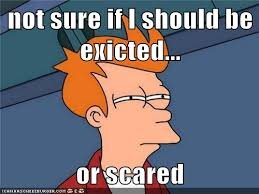Following up on my introduction to anxiety, I will walk you through a closer look at how I conceptualize it to help my patients; thoughts from the work of Daniel Kahneman, Richard Lazarus, and Jon Frederickson. I’ll begin by sharing a powerful idea from psychologist and Nobel Laureate Daniel Kahneman that help understand how I link the other two conceptualizations.

Kahneman preaches the danger of a psychological phenomenon he dubs “What You See Is All There Is” (WYSIATI). It is explaining to yourself what has happened, what is happening, and what will happen by accepting what your mind and senses tell you is obvious, without doing the hard work of looking for more information.
The oft-noted phenomenon “What You Allow is What Will Continue” is closely related; we often see people treating us in ways we don’t like or want, yet are unwilling to say or hold our boundaries. In both there is a certain laxness involved, and thinking with either of these mental errors contributes mightily to anxiety.
Based on my personal and clinical experience, I add a third problem which is to my mind more vexing still because it includes an active element; “What You Allow Yourself To Engage With Is What Will Occupy Your Life.” Engaging with people and thoughts that undermine your self-acceptance, that deflate you and keep you from flourishing and growing, is clearly a pestilence.
It’s bad enough if the people are well-meaning or neutral; for instance, if we compare ourselves to a friend or even a famous person who seems to be ‘better’ than us in some way, or if we pursue the company of people who don’t want us. These are bound to hurt our feelings and self-regard.
It’s all the worse when you choose to engage with people who purposely hurt you; people who challenge your confidence, feelings of self-worth, or those who emotionally attack and drain you, like internet trolls and other bullies.
If you engage with them in good faith when they aren’t going to do the same for you, you will end up anxious, hurt, and perhaps worse, no matter how resilient you are.

And if you engage with these toxic situations, thoughts, or people ad nauseum, then you are going to quite literally make yourself sick. That’s not the life you want to live. What can be done?
The prescriptions for these problems are straightforward: 1) Take time to think through situations that give you anxiety: you’re probably overweighting unhealthy and false beliefs or ‘evidence’; 2) Figure out your interpersonal boundaries, and see which ones have to be firm and which can be a bit flexible, then stick to them; 3) Don’t try to keep people or ideas in your life if doing so helps them and hurts you.
You deserve to be reasonably satisfied with your interpersonal connections, and similarly the opinions and ideals you cherish ought to be enriching your life. If you don’t do these three things, you’re going to be more anxious than you need to be.
While it is good to have a healthy dose of humility, it’s been my experience that people are usually far too dismissive of their capabilities and value. I continually see people who are absolutely smart enough, friendly enough, attractive enough, talented enough to flourish, who spend countless hours undermining themselves by obsessing and worrying over their perceived flaws. We all have flaws but very few of us have flaws that would absolutely keep us from flourishing.
One way to start the process of only allowing yourself to engage with useful thoughts and supportive relationships is to challenge yourself to be conscious of how you set up problems, and to realize that if you may have a strong tendency to formulate them in ways that only serve to make you more anxious. If you know this about yourself, and you start to get down about things, ask yourself what Kahneman advises: “If I formulate this in a different way, would I get a different answer?”

Studying Richard Lazarus’ work on emotions has convinced me that anxiety is the psychological parallel to fear. When my physical body is in danger, when I could break a limb or die, I experience fear. When my identity is in danger, when my sense of self could be shattered or ‘die’, I experience anxiety. When something in the world tells me that the way I perceive myself, my value, has been put into question, I have anxiety.
We all want to be appreciated, to believe we are valuable, loveable, reasonable, etc., and thus can expect care, commitment from our loved ones, respect, and ultimately to feel safe. When we interact with the world and we get explicit messages to the contrary, we’re going to naturally be anxious. But our brains often find, create, or even offer us ‘evidence’ of problems in these areas when they aren’t really there, often through one or more of the errors discussed above.
The second conceptualization, while not literally ‘correct’, is still a great way to talk about anxiety in the therapy room. In Co-Creating Change therapist Jon Frederickson counsels that anxiety functions like a pall or a drop cloth; it covers up other ‘real’ emotions. When we experience anxiety it’s basically that our brain is choosing to be uncomfortable in this way, and set itself upon more ‘acceptable’ problems, rather than choosing to feel and work through a problem that is much more pertinent, but much more painful in the short term.

Consider a person who was punished or ignored whenever they showed anger growing up. This child will grow up to be afraid of their anger, and thus when in a situation that would rightfully make them angry, the brain will instead hit the anxiety button and come up with some other situation to obsess over, thus covering up the ‘riskier’ path of dealing with their anger.
In therapy we can pretty easily work with both of these conceptions. With either we can understand anxiety as a tell; something deadly serious is happening relative to me and my deepest beliefs and goals about myself and the world. Using Fredrickson, the way of handling it is teaching a person to differentiate between different emotions, to make the healthy choice to really listen to their messages, and to learn to do the hard work of determining how accurate they are and what to do about them.
Most often, the problems the brain fixates on are worries about the future, about things that don’t actually exist or aren’t happening. They very often lead to desperation to avoid these potential situations, which ironically leads people to act unhealthily, and thus making bad outcomes much more likely.
Using Lazarus is more straightforward, but requires the core work of emotional differentiation and understanding to have been done on some level. We see that we are anxious and know it is because we feel personally threatened, and we need to either reinforce our ego strength, resolve the threat, or both. Depending on the strengths and overall presenting problems of the patient, the therapist can guide the conversation with either conceptualization.
Hopefully this gives you some ability to gain insight into your own anxieties. But sometimes anxieties and their related unhealthy behaviors and relationships need the help of a mental health professional, so you shouldn’t be shy about seeking that out.
It’s better to invest in help to learn to properly engage with the world than to let anxiety cause you needless suffering.